
- ChatGPT - Home
- ChatGPT - Fundamentals
- ChatGPT - Getting Started
- ChatGPT - How It Works
- ChatGPT - Prompts
- ChatGPT - Competitors
- ChatGPT - For Content Creation
- ChatGPT - For Marketing
- ChatGPT - For Job Seekers
- ChatGPT - For Code Writing
- ChatGPT - For SEO
- ChatGPT - For Business
- ChatGPT - Machine Learning
- ChatGPT - Generative AI
- ChatGPT - Build a Chatbot
- ChatGPT - Plugin
- ChatGPT - GPT-4o (Omni)
- ChatGPT in Excel
- ChatGPT for Test Automation
- ChatGPT on Android
- Make Money with ChatGPT
- ChatGPT for UI/UX Designers
- ChatGPT for Web Developers
- ChatGPT for Data Scientists
- ChatGPT for Bloggers
- ChatGPT for Personal Finance Management
- Automate Customer Support with ChatGPT
- Create Content Calendars with ChatGPT
- Plan Events and Trips with ChatGPT
- Draft Legal Documents with ChatGPT
- Improve Your Coding Skills with ChatGPT
- New Language with ChatGPT
- Optimize ChatGPT Responses for Better Accuracy
- ChatGPT Useful Resources
- ChatGPT - Quick Guide
- ChatGPT - Useful Resources
- ChatGPT - Discussion
ChatGPT Quick Guide
ChatGPT Fundamentals
Have you ever imagined having a digital companion that not only comprehends your words but also delivers coherent responses? If not, consider ChatGPT, as that's precisely the function it performs! In this opening chapter, let's have brief overview of how ChatGPT evolved and some of its popular use cases.
The Evolution of ChatGPT
Just 5 days after OpenAI unveiled the web preview of ChatGPT, the service notched up a staggering 1 million users! ChatGPT's succcess ignited a worldwide surge in AI innovation.
Since it first came out, OpenAI has been working hard to make ChatGPT even better. They started with a Pro version using the powerful GPT-4 model. After that, they added features like web browsing and creating images with Dall-E.
Now, ChatGPT is not just for chatting; it can do much more, for example, looking at the web and making pictures. This continuous evolution underscores OpenAI's dedication to refining and expanding the capabilities of ChatGPT to offer users a dynamic conversational AI experience.
Use Cases of ChatGPT
People often call ChatGPT the "do-anything-machine" because it's great for getting lots of different jobs done. If it can't do something, it can probably tell you how to do it. Many users find it the best choice for all sorts of tasks, making it a top pick for general work.
ChatGPT has showcased impactful use cases across diverse industries. Let's explore some of them in this section.
ChatGPT for Code Writing
Ever wished for a coding buddy? Developers are leveraging ChatGPT as their coding companion, utilizing its capabilities to streamline the writing, understanding, and debugging of any code.
ChatGPT is becoming an essential tool in the coding process, offering valuable guidance and support throughout development tasks.
Example
Lets check out an example below that generates a Python program for reversing a string −
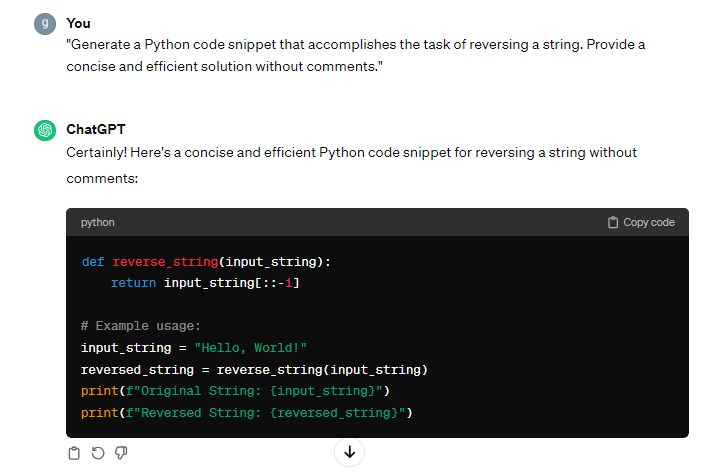
ChatGPT for Content Creation
Make writing fun with ChatGPT! Creators are using ChatGPT to unlock their creative potential. Whether they are crafting stories or blogs, it assists in generating engaging content, providing inspiration, and simplifying the writing process. It also assists in summarizing the book or article.
Example
Lets check out an example that writes a Facebook post description about free online courses for AI with Python −
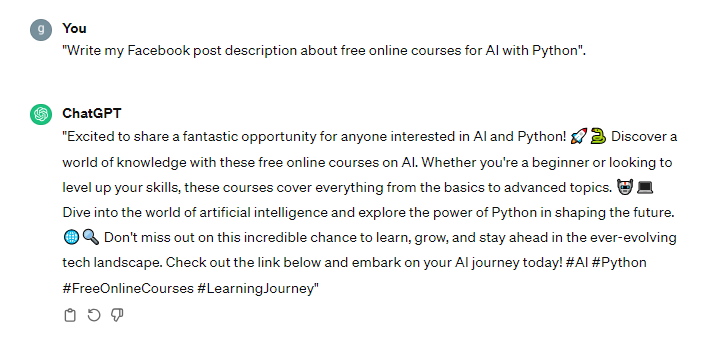
ChatGPT for Marketing
Businesses are using ChatGPT to elevate their marketing strategies by creating custom marketing plans or strategies. It actively contributes to crafting ads, writing appealing content, and adapting to trends, making it a valuable ally in enhancing brand image.
Example
Here is an example in which we are using ChatGPT to write Google Ad headlines and descriptions for IT company −

ChatGPT for Job Seekers
Job seekers are turning to ChatGPT as their career coach. They are utilizing this LLMs capabilities to craft resumes, write compelling cover letters, and prepare for interviews by answering interview questions, finding valuable support in their job search journey.
Example
Lets see how we can use ChatGPT to write a cover letter for a software engineer role −
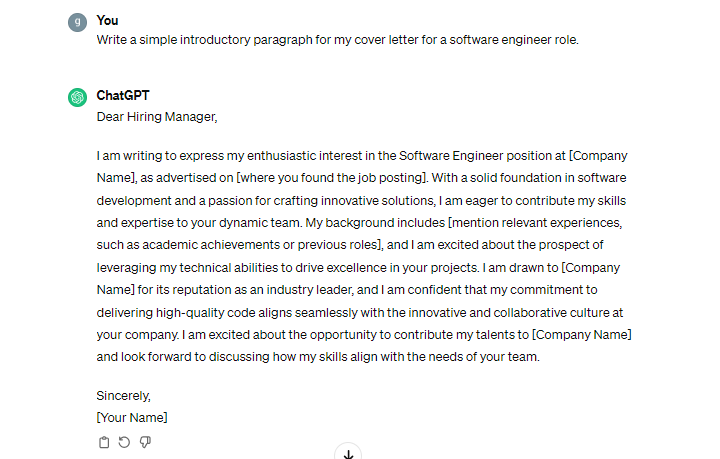
ChatGPT for SEO
Online content creators are using ChatGPT to enhance their SEO efforts. It actively generates SEO-friendly content, meta descriptions, and blog posts, ensuring that their online presence is easily discoverable by search engines.
Example
In this example, we use a prompt to generate 10 long-tail keyword ideas for a business that provides IT solutions to other businesses −

ChatGPT in Healthcare
Professionals in the healthcare sector are integrating ChatGPT into their workflows. They are using it for clinical decision support, medical recordkeeping, and disease surveillance, information retrieval, and as a virtual assistant, improving overall efficiency in healthcare tasks.
Example
Lets see an example in which ChatGPT compare the efficacy of two different approaches for chronic pain management −
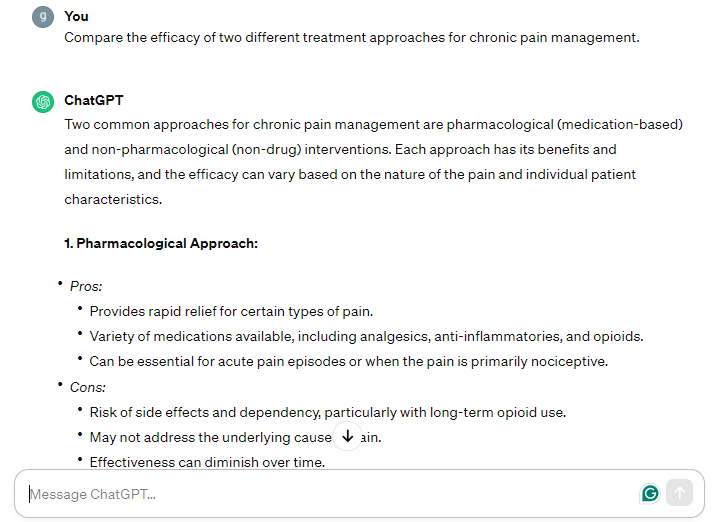
ChatGPT for Customer Service
Make talking to companies easier with ChatGPT! Companies are incorporating ChatGPT to simplify customer interactions. They are using it to assist with queries, provide information, and ensure a positive user experience, enhancing the quality of customer service.
Example
In this example, we as a Grocery Store, assisting the customer and offering solution through ChatGPT −
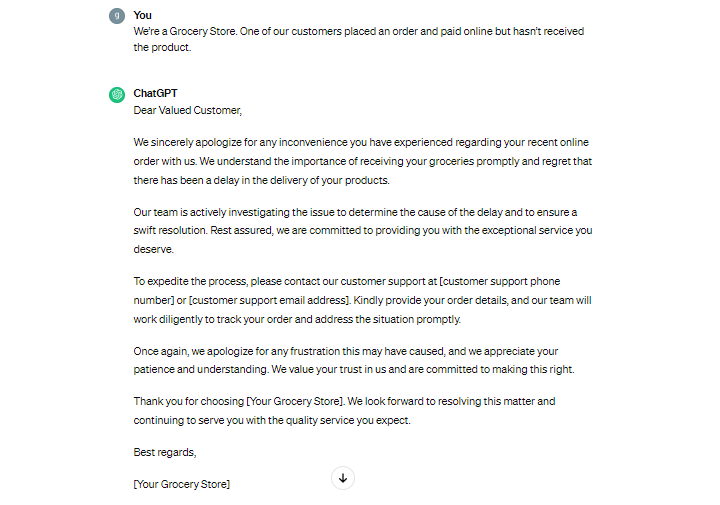
ChatGPT for Education
ChatGPT is like a study buddy! Students and educators alike are using ChatGPT as virtual tutors. It assists in explanations of complex subjects, answers questions, and makes learning interactive across various subjects, providing valuable support in educational contexts.
Example
Lets see how ChatGPT summarize the life of Mahatma Gandhi for students and teachers −
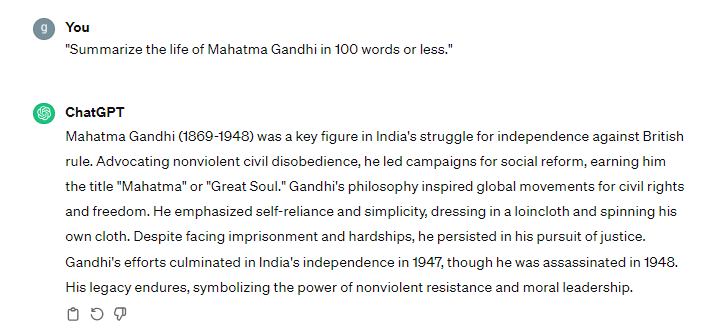
ChatGPT for Entertainment
Writers and creators are using ChatGPT to spark their creativity. It actively contributes to generating plot ideas, video game storylines, writing movie scripts and dialogues, and creating engaging content, making it an invaluable tool in the entertainment industry.
Example
In the example below, ChatGPT is writing a short story having Basketball the main character −
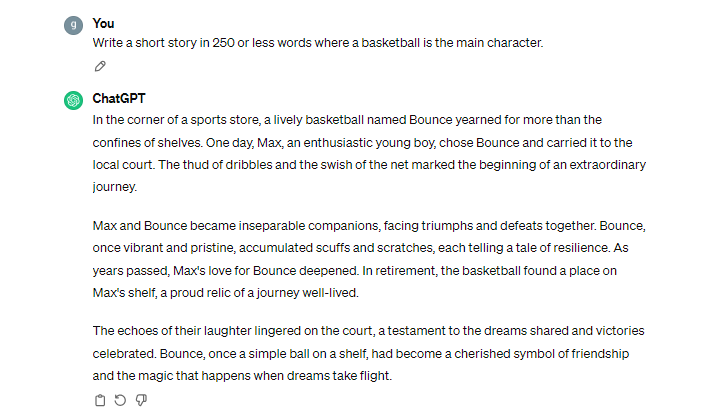
ChatGPT as Your Daily Assistant
Meet your everyday helper! Individuals are relying on ChatGPT as their everyday helper to make their daily tasks seamless and enjoyable. They are using it for weather updates, setting reminders, and obtaining quick answers to queries, making exercise and diet plans.
Example
Lets see how we can get some nutritious vegetarian recipes from ChatGPT −
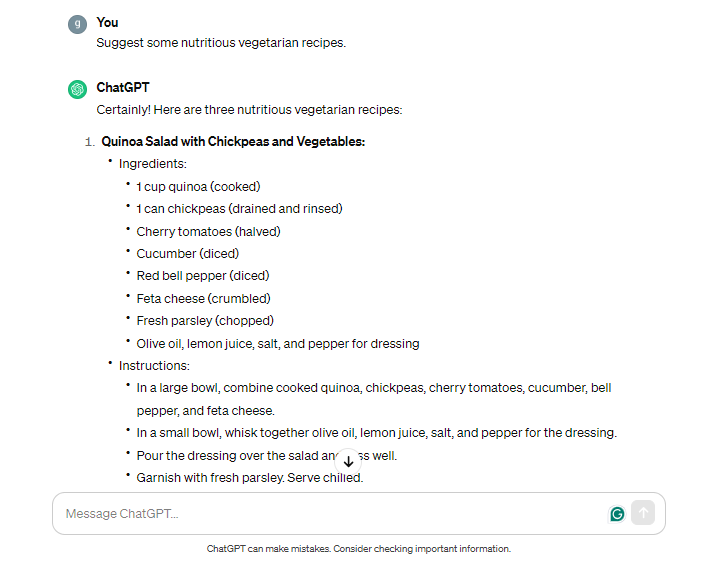
Other companies are observing the widespread popularity of ChatGPT, a part of a wave of so-called generative AI, and are exploring ways to integrate LLMs into their products and services.
Microsoft, a strategic partner of OpenAI, has seamlessly integrated this technology into its core products, such as the MS 365 Suite. Bing, the search engine adopted GPT technology to rival Googles dominance.
Google has incorporated conversational AI features into its primary search product and unveiled its chatbot named Bard which is powered by LaMDA (Language Model for Dialogue Applications).
We will cover these use cases in detail in the subsequent chapters.
Limitations of ChatGPT
As an AI language model, ChatGPT demonstrates its prowess in an array of tasks such as language translation, songwriting, research queries, and even generating computer code. This versatility positions ChatGPT as a popular tool for various applications including marketing, daily assistant tasks, healthcare support, SEO optimization, and customer services.
Despite these capabilities, it's important to acknowledge that ChatGPT, like any AI technology, comes with its set of limitations. In this section, we will explore some limitations of ChatGPT, ranging from limited context understanding to potential for creating inappropriate content. Understanding these limitations provides insights into the challenges one might encounter when employing AI language models across different domains.
Limited Context Understanding − ChatGPT may struggle with nuanced or lengthy contexts, leading to responses that lack understanding beyond a certain point.
Potential Bias in Outputs − ChatGPT may inadvertently generate biased or sensitive content, necessitating caution in applications to ensure fairness and inclusivity.
Inability to Verify Information − ChatGPT may generate information that is factually incorrect or unverified, highlighting the need for external fact-checking to ensure accuracy.
Tendency to Over Generate − Prone to verbosity, ChatGPT may produce overly detailed or verbose responses, affecting clarity and efficiency in communication.
Lack of Real-world Knowledge − With a knowledge cutoff date, ChatGPT may lack awareness of recent events or updates, potentially providing outdated information.
Sensitivity to Input Phrasing − Responses can vary based on slight changes in input phrasing, leading to inconsistency.
Potential for Inappropriate Content − Despite efforts to filter inappropriate requests, ChatGPT may inadvertently generate content that violates ethical or community standards.
Legal and Ethical Issues in Using ChatGPT
Below find the legal and ethical concerns associated with the utilization of ChatGPT and other extensive large language models −
Legal Issues
Liability − It is a challenge to determine the responsibility for any unintended consequences of using ChatGPT. There should be clear legal frameworks to establish accountability.
Intellectual Property − There is a necessity to have strict policies in order to navigate copyright laws and ensure compliance.
Ethical Issues
Privacy − ChatGPT interactions might sometimes involve sensitive data.
Transparency − It's vital that the users remain fully aware regarding the drawbacks of ChatGPT during their interactions. There must be clear disclosures about the AI system's nature and limitations to manage expectations.
Security Risks − ChatGPT can be vulnerable to adversarial attacks and data breaches. There is a requirement for robust security measures such as encryption and continuous monitoring.
Addressing these issues requires ongoing collaboration between developers and regulators in order to establish proper legal frameworks and ethical guidelines.
ChatGPT Getting Started
Getting started with ChatGPT is easy! You can use ChatGPT through the OpenAI platform. In this chapter, we will show, in a step-by-step way, how you can set up an account at OpenAI and start using ChatGPT.
Setting Up an Account on OpenAI
If you're already a registered OpenAI user and have previously utilized ChatGPT, feel free to skip this chapter and proceed to the next one. Otherwise, to get started with ChatGPT, you need to create an account at OpenAI. Follow the instructions given below.
Visit the OpenAI website at this link: https://openai.com. Then you need to click the Try ChatGPT button on the homepage.
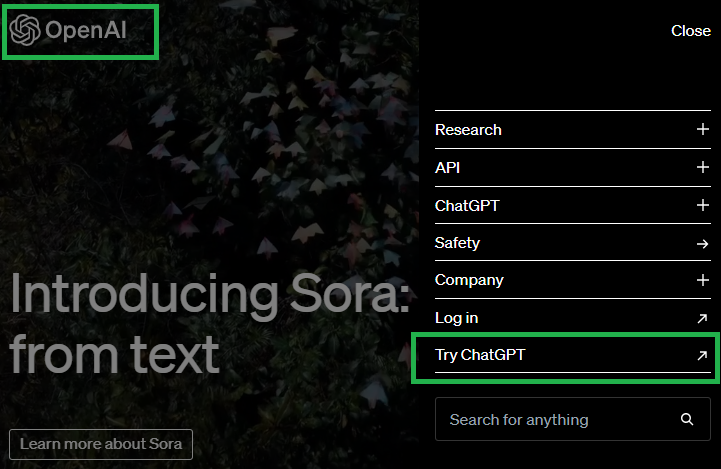
Next, youll get ChatGPT landing page with login and signup options as shown here −

Now, it is required to set up the account using your email address. Alternatively, you can proceed by using your Google, Microsoft, or Apple account. The resulting landing page will be displayed as depicted below −
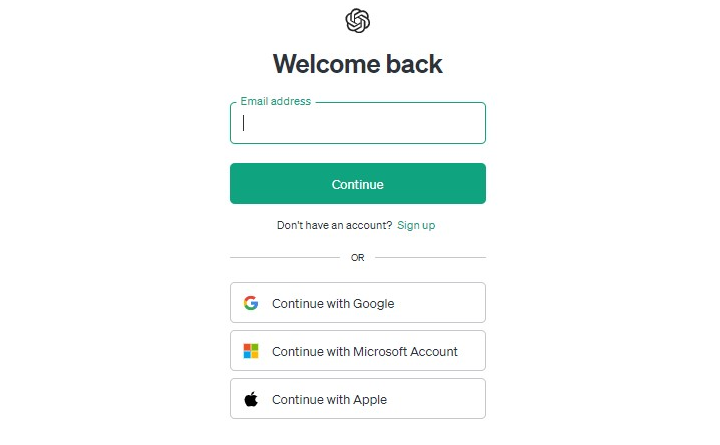
Write Your First Prompt in ChatGPT
Great! Now you can start using the ChatGPT web app. You can initiate by entering your own prompt or explore the suggestions provided by ChatGPT. This allows you to carry out diverse natural language processing tasks directly within your web browser.
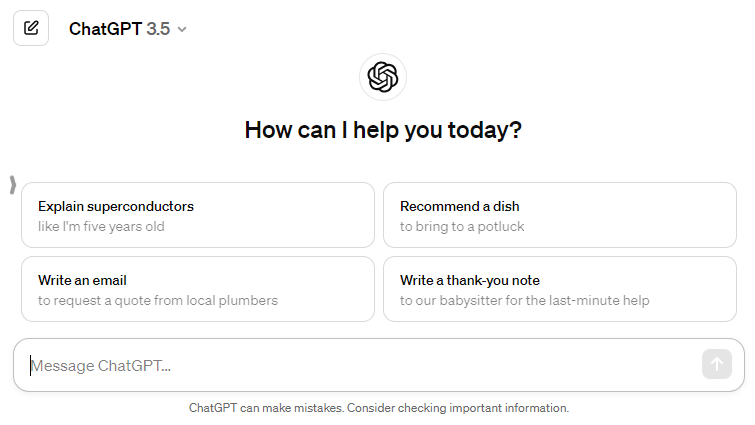
Now, you also have the option to download ChatGPT from both the Google Play Store and Apple App Store, enabling you to enjoy it on your Android and Apple devices.
Organizing Chats A Time-Saving feature
ChatGPT offers a time-saving capability by allowing users to have multiple open threads or chats. Upon initiating your initial prompts, ChatGPT will automatically create a new chat and assign it a relevant title. Refer to the top-left corner of the provided screenshot for details.
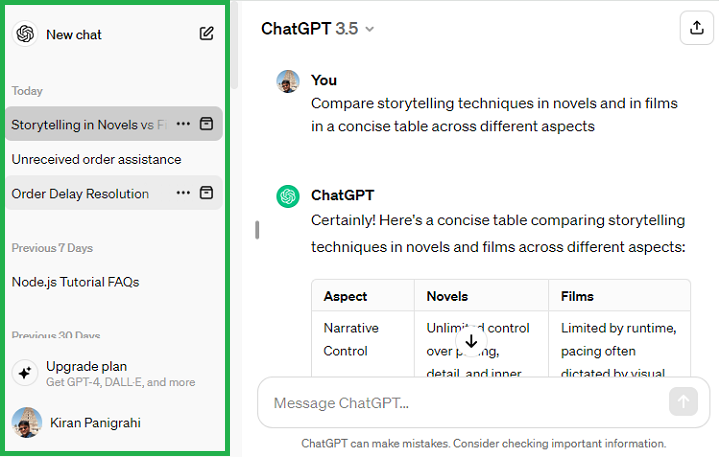
Feel free to begin fresh chats whenever you choose, but there might be instances where you'd like to pick up a conversation initiated a few days ago.
Suppose you have asked about Machine Learning to ChatGPT and after that you engage with other follow-up questions. For example, given below is a screenshot of the progression of the interaction −
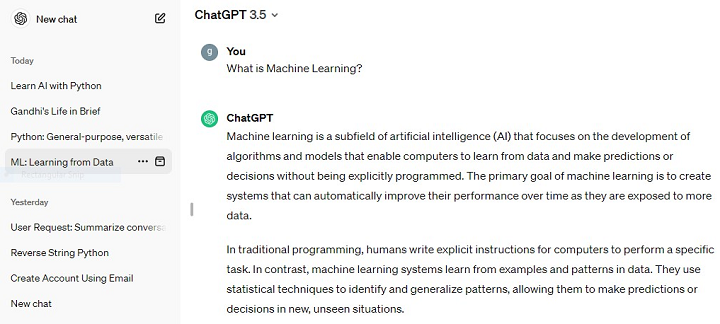
Now, at this moment in the chat, ChatGPT is contextually aware, allowing you to carry on with your conversation without repeating concepts. Take a glance here for further details −
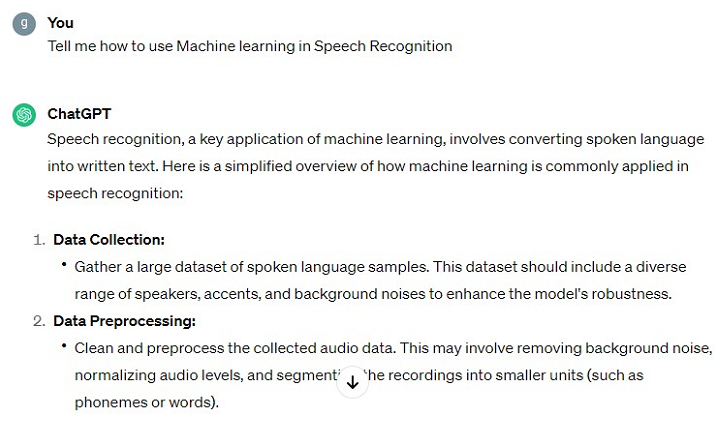
With the above examples, we can see how chats in ChatGPT are maintained and organized. It makes it convenient to refer to the older chats.
ChatGPT Prompts
We used the word "prompt" while discussing how users interact with ChatGPT and other Open AI models. In this chapter, we will discuss the significance of "prompt engineering" to enhance models accuracy.
The way prompts are designed and crafted influence the output of the model in the following ways −
A well-designed prompt can guide the model to produce relevant and precise output.
Whereas a poorly designed prompt may result in irrelevant or confusing output.
This is just a basic chapter on how you can use different types of prompts in ChatGPT to get the exact information you are looking for. We would like you to refer our tutorial Prompts Engineering where you will find extensive detail on this topic.
Prompts and Their Significance
Generative AI models can create various things like poems, stories, images, and code as per user request. However, to get the output we want, we have to give these models the right instructions, known as prompts.
Prompts, which mainly refer to a segment of text in natural language, are like the guide for the generative AI model's output, affecting its tone, style, and overall quality. In fact, prompts are the only way a user can direct the output generated by these models.
Types of Prompts for ChatGPT
The categories of prompts used in ChatGPT act as guidelines or instructions provided to GPT to steer and control specific kinds of responses and conversations. Let's explore the commonly used prompts and understand the ways they can be beneficial.
Instructional Prompts
Instructional prompts are commands that direct the model with specific instructions on the desired format or information to include in the response.
Lets see an example below −
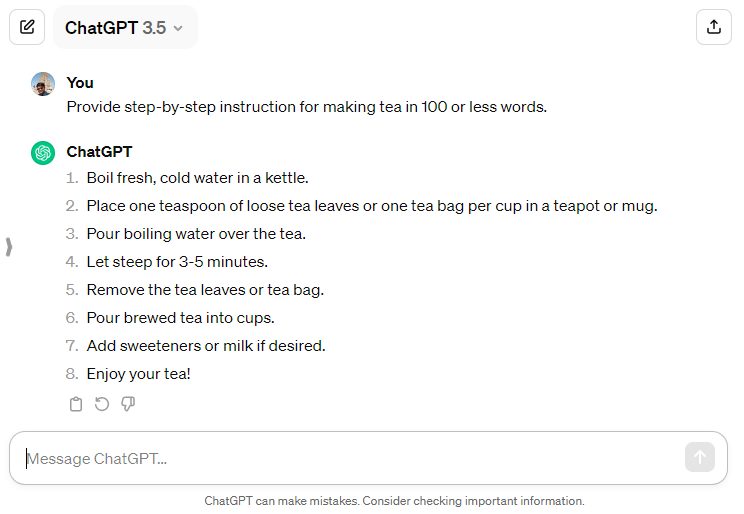
Roleplay Prompts
Roleplay prompts are commands that frame the input as if the model is a character or has specific role, guiding its response accordingly.
Consider the following example −
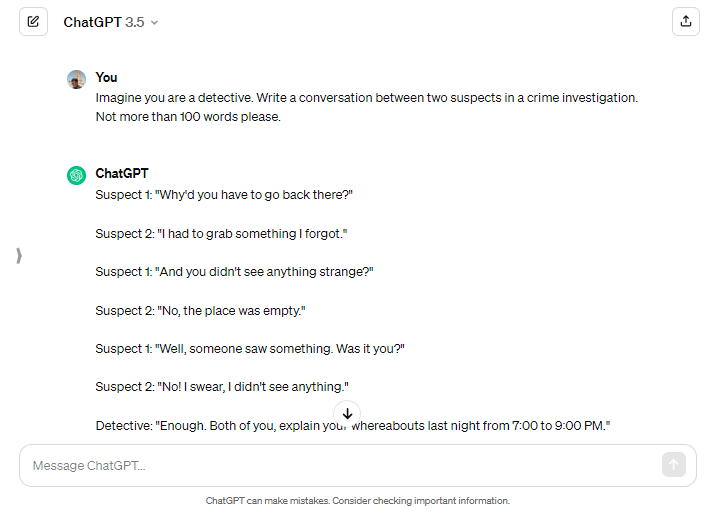
Question-Answer Prompts
As the name suggests, QA prompts are commands that pose questions to the model to elicit informative or creative answers.
Take a look at the following example −
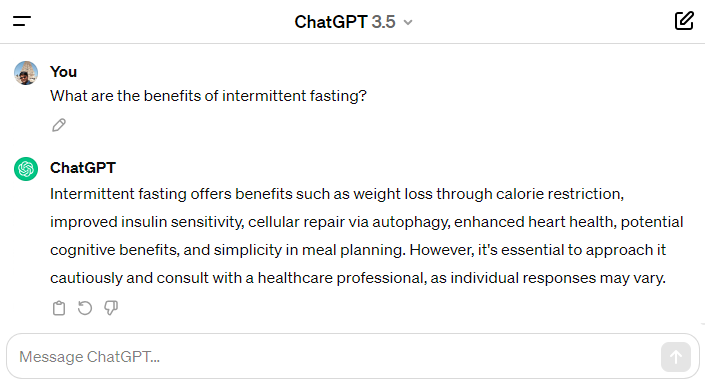
Contextual Prompts
Contextual prompts provide context or background information to guide the models understanding and response.
Check the following example −
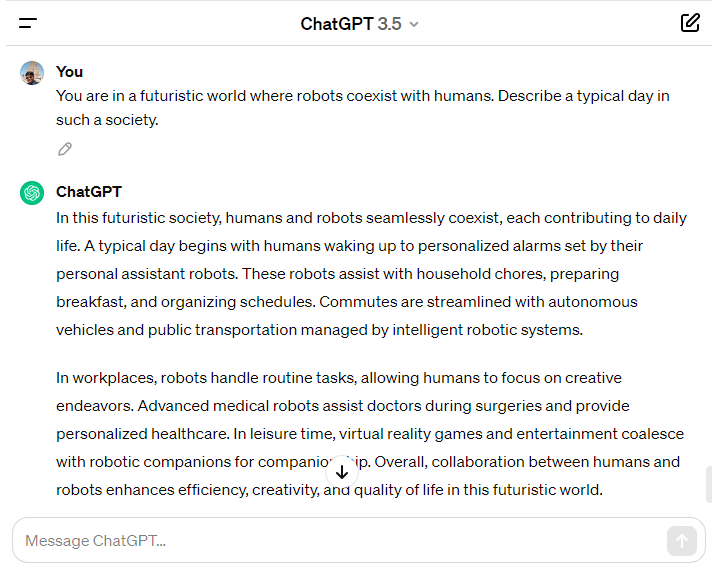
Creative Storytelling Prompts
Creative storytelling prompts encourage the model to generate imaginative or creative narratives by setting up scenarios or story elements.
Observe how the following prompt works in this example −
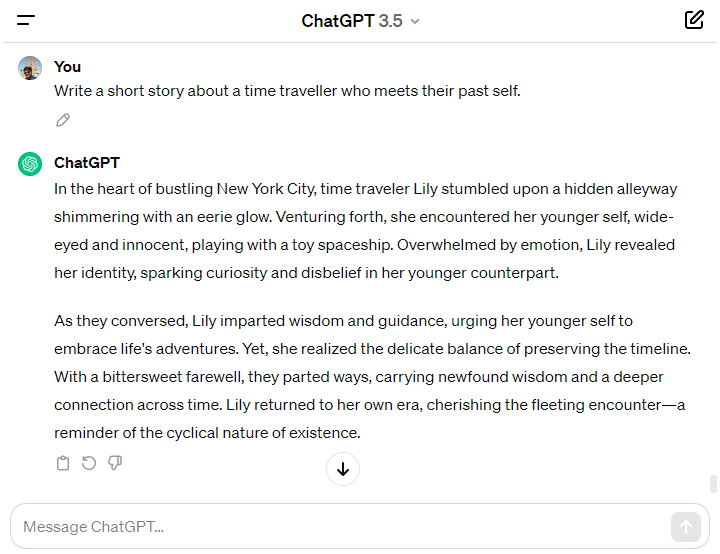
Conditional Prompts
Conditional prompts specify conditions or constraints for the response to guide the model's output in a particular direction.
Explore the following example −
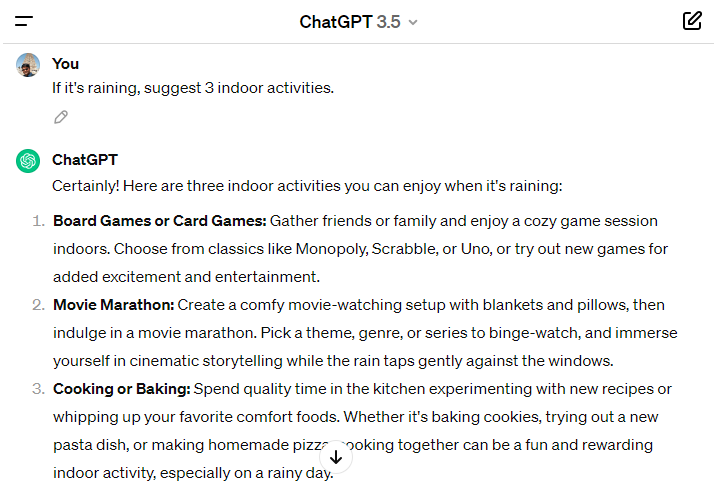
Comparison Prompts
Comparison prompts ask the model to compare or contrast different concepts, ideas, or scenarios. Consider the following example −
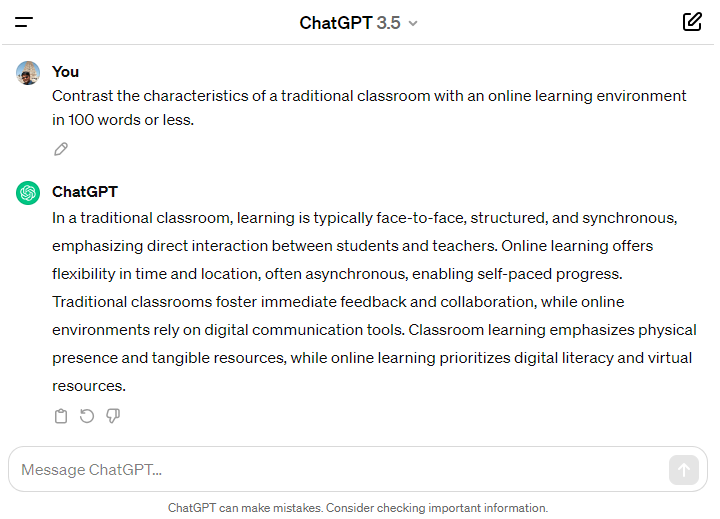
Instructive Prompts
Instructive prompts clearly instruct the model on the desired behavior or approach in its response. Take a look at the following example −
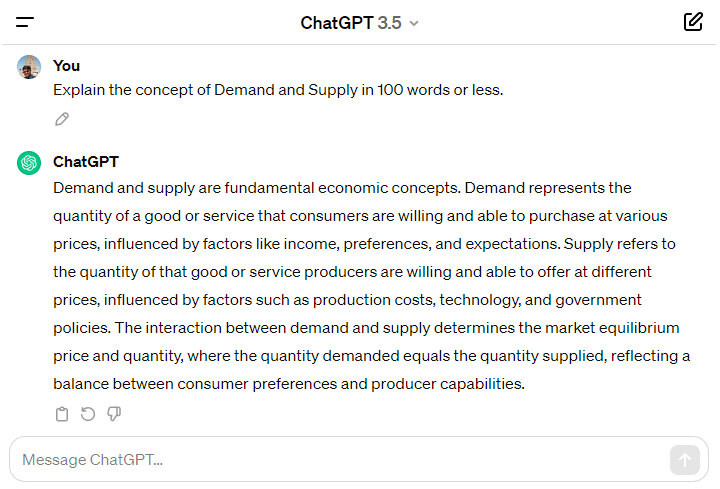
Principles of Well-Defined Prompts
In the earlier discussion, we emphasized the significance of prompt engineering in influencing model output. Now, let's delve into recommended practices for improving your prompts and identify some practices to avoid.
Ensure Clarity
Frame your sentences and instructions in a simple manner, making them easily understandable for ChatGPT.
Be Concise
Choose shorter prompts and sentences. Break your instructions into smaller, coherent sentences for improved understanding.
Maintain Focus
Ensure that the prompt centers on a clearly defined topic to avoid the risk of producing overly generic output.
Consistency
Maintain a consistent tone and language during the conversation for a more coherent interaction.
Acting as
The technique of having ChatGPT assume the identity of someone, or something has shown remarkable effectiveness. You can streamline the information you need from the model by instructing it to "act like" the desired person or system.
Weve already seen the roleplay prompt example in the previous section, where ChatGPT acted as a detective.
ChatGPT Competitors
Over the years, various iterations of ChatGPT have been developed, each bringing improvements and additional features to the table. The key versions include −
GPT-1 − Introduced in 2018, GPT-1 served as the inaugural model in the GPT series, focusing on text generation.
GPT-2 − Unveiled in 2019, GPT-2 elevated the game with 1.5 billion parameters. It garnered attention for its highly persuasive text generation capabilities, albeit sparking concerns about disinformation.
GPT-3 − Launched in 2020, GPT-3 stands as the most recent and advanced version in the GPT series, boasting 175 billion parameters. Applauded for its heightened ability to generate more natural text and perform diverse natural language processing tasks.
GPT-4 − Unveiled in 2023, OpenAI claims that "GPT-4 can solve challenging problems with greater accuracy, thanks to its broader general knowledge and advanced reasoning capabilities."
Each iteration has played a crucial role in elevating the quality and precision of automated text generation, facilitating more natural and seamless communication between chatbots and users.
In fact, ChatGPT's capabilities are expected to undergo significant evolution in the coming years, especially with OpenAI actively working on the next-generation GPT-5 language model.
Competitors of ChatGPT
While ChatGPT holds a prominent position, various competitors, including Google, Meta, Anthropic, and Amazon, are using Large Language Models (LLMs), deep learning, and fine-tuning to establish their dominance in the market.
Within the AI Large Language Model (LLM) domain, there are several promising competitors to ChatGPT. In this chapter, we will explore each of these alternatives to ChatGPT individually.
Google Gemini (Formerly Google Bard)
Google Gemini is a formidable competitor to ChatGPT. It made its debut in March 2023 as a conversational AI chatbot employing machine learning (ML), natural language processing (NLP), and generative AI to comprehend user prompts and furnish text responses.
In contrast to ChatGPT, Gemini has the unique capability to access the Internet, integrating information scraped from recently published content into its responses.
Initially trained on Google LaMDA, a large language model (LLM), Gemini underwent a transformative re-training in May 2023, transitioning to the more advanced Pathways Language Model 2 (PaLM 2). Google asserts that PaLM 2 processes information up to 500 times faster than LaMDA and achieves a remarkable tenfold increase in accuracy.
Google rebranded the Bard chatbot as Gemini on February 8, 2024.
Midjourney
Midjourney is an innovative AI tool, specializing in swiftly transforming prompts into images. With its monthly model updates, Midjourney continues to push the boundaries of creative AI.
As Midjourney operated on a self-funded and closed-source basis, its intricate workings remain undisclosed. The platform employs machine learning technologies, incorporating large language and diffusion models.
In contrast to counterparts like ChatGPT and Bing Chat, Midjourney adopts a unique approach with a subscription-based model, requiring graphics processing units (GPUs) for optimal performance.
While lacking a free trial, the basic plan, priced at $10, facilitates the generation of over 200 images upon command.
Claude 2
In July 2023, Anthropic, an AI company, unveiled its latest chatbot named Claude 2 which is powered by a large language model.
Claude 2 represents a notable upgrade from Anthropic's previous AI iteration, Claude 1.3. Noteworthy improvements include enhanced code-writing capabilities based on written instructions and an expanded "context window." Users can now input entire books and pose questions to Claude 2 based on their content.
These enhancements position Claude 2 on par with leading models like GPT-3.5 and GPT-4, which drive OpenAI's ChatGPT.
To meet claude 2, sign up at https://claude.ai/.
Runway ML
Runway ML represents a groundbreaking platform designed for artists, designers, and creators to use the potential of machine learning. Runway ML empowers users to craft videos using text prompts, alter video styles using text or images, and craft personalized portraits, animals, styles, and beyond.
Simple and accessible, Runway ML eliminates the necessity for in-depth programming knowledge. A standout feature of Runway ML lies in its AI Magic Tools, which facilitate real-time video editing, collaboration, and a myriad of other functionalities.
The creative potential with Runway ML's AI Magic Tools is boundless, offering a diverse range of possibilities.
GitHub Copilot
GitHub Copilot, introduced in 2021, is a revolutionary coding assistant developed by GitHub in collaboration with OpenAI.
Seamlessly integrated into popular code editors, Copilot offers developers real-time code suggestions and autocompletions. Powered by OpenAI's Codex, it draws insights from a vast array of public code repositories, providing context-aware code snippets to enhance coding efficiency.
Copilot transforms the development landscape by assisting developers with intelligent code generation, fostering productivity, and making coding more accessible. Unlike ChatGPT, which focuses on natural language conversations, GitHub Copilot is uniquely tailored to expedite code production.
Perplexity AI
Perplexity AI, released in August 2022, functions as an AI chatbot with search engine capabilities. It is built upon GPT-3 and GPT-4 that employ sophisticated technologies like natural language processing (NLP) and machine learning. This enables the platform to deliver precise and thorough responses to user queries.
Tailored for real-time web searches, Perplexity AI ensures access to the latest information across diverse topics. Fueled by robust language models, particularly OpenAI's GPT technology, the platform excels in comprehending and generating human-like text. Positioned as an answer engine, Perplexity AI strives to enhance the way individuals explore and exchange information.
Perplexity AI is conveniently accessible to a diverse user base, with both web and iPhone app versions available. Users can freely utilize Perplexity AI by visiting their website.
Follow these steps to engage with Perplexity AI −
Navigate to www.perplexity.ai.
Pose your question by entering it into the search bar and clicking the blue arrow.
Evaluate Perplexity AI's response along with the provided sources.
Continue the interaction by asking follow-up questions using the "Ask a follow-up" bar below.
Meta Llama 2
Llama 2 is Metas large language model (LLM) that can generate text and code while optimizing computing power and resources.
Llama 2 achieves a Massive Multitask Language Understanding (MMLU) score of 68.9, just slightly trailing GPT 3.5's 70.0. While it falls short of GPT-4's 86.4 rating, this proximity establishes Llama 2 as a credible open-source competitor to GPT 3.5.
It's important to highlight that Llama 2's training data extends up to September 2022, with additional tuning data as recent as July 2023. In contrast, GPT 3.5's training data only covers up to September 2021. This distinction positions Llama 2 as a source of more current information compared to its OpenAI counterpart.
Amazon CodeWhisperer
Amazon CodeWhisperer, an AI Code Generator from AWS, is trained on vast code repositories, offering real-time code suggestions ranging from snippets to complete functions based on comments and existing code.
Streamlining coding tasks, it supports 15 programming languages, including Python, Java, and JavaScript, and integrates with popular IDEs like VS Code, IntelliJ IDEA, AWS Cloud9, AWS Lambda console, JupyterLab, and Amazon SageMaker Studio.
The free Individual Tier includes unlimited code suggestions, reference tracking, and 50 security scans per user monthly. CodeWhisperer has built in security scans that can detect vulnerabilities and provide immediate remediation suggestions.
CodeWhisperer also incorporates a reference tracker flagging open-source similarities in suggestions. Annotating such suggestions with repository URLs, file references, and license details allows users to review the code before its implementation.
D-ID Studio
D-ID's Creative Reality Studio, also known as Studio D-ID, stands as a self service platform that uses generative AI tools very efficiently. It empowers users to craft videos featuring dynamic, conversing avatars.
This platform seamlessly integrates D-ID's deep-learning face animation technology with GPT text generation and Stable Diffusion text-to-image capabilities. D ID is the first all-in-one solution for those aiming to produce innovative videos using AI.
Operating as a web-based tool, Creative Reality Studio employs state-of-the-art face animation and text-to-speech technologies to deliver life like conversational AI experiences.
This versatile technology finds applications in crafting digital renditions of individuals, historical figures, fictional characters, presenters, or brand ambassadors. In fact, studio D-ID breathes life into content, providing a dynamic alternative to mundane documents and PowerPoints.
ChatGPT For Content Creation
Since its launch, ChatGPT has captured the attention of content creators faster than expected. In this chapter, we will see various ways to use ChatGPT for content creation. Along with that, we will also see Python implementation using OpenAI API.
Get an API Key from OpenAI
First of all, you'll need to sign up on the OpenAI platform and obtain an API key. Once you have your API key, you can install the OpenAI Python library as follows −
pip install openai
Now, you're ready to infuse your content creation projects with the creative capabilities of ChatGPT.
Generating Text Using ChatGPT
In its capacity as a language model, ChatGPT excels at crafting text in accordance with user prompts.
For example, you can use ChatGPT to generate a story as below −
import openai # Set your OpenAI API key openai.api_key = 'your-api-key-goes-here' # Define a prompt for text generation prompt = "Write a short story about a detective solving a mysterious case." # Specify the OpenAI engine and make a request response = openai.Completion.create( engine=" gpt-3.5-turbo-instruct", prompt=prompt, max_tokens=100 ) # Extract the generated text from the API response generated_text = response['choices'][0]['text'] # Print or use the generated text as needed print(generated_text)
Note − Replace "your-api-key-goes-here" with your actual OpenAI API key. The above example prompts the model to generate a short story about a detective, and you can customize the prompt and other parameters based on your specific use case.
In this case, we got the following output −
Detective Mark Reynolds had been on the force for over a decade. He had seen his share of mysteries and solved his fair share of cases. But the one he was currently working on was unlike any he had encountered before.
Note that the system may produce a different response on your system when you use the same code with your OpenAI key.
Generating Video Scripts Using ChatGPT
As we know generating video content requires scripting and ChatGPT can help you in the creation of video scripts. You can utilize the generated text as a foundation for initiating your video content creation journey. Lets check out the below example −
import openai # Set your OpenAI API key openai.api_key = 'your-api-key-goes-here' # Define a prompt for generating a video script prompt = "Create a script for a promotional video showcasing our new AI product." # Specify the OpenAI engine and make a request response = openai.Completion.create( engine="gpt-3.5-turbo-instruct", prompt=prompt, max_tokens=100 ) # Extract the generated script from the API response generated_script = response['choices'][0]['text'] # Print or use the generated script as needed print(generated_script)
In this case, we got the following output −
[Opening shot of a modern office space with employees working at their desks] Voiceover: Are you tired of mundane tasks taking up valuable time at work? Do you wish there was a way to streamline your workflow and increase productivity? [Cut to employees looking stressed and overwhelmed] Voiceover: Well, look no further. Our company is proud to introduce our latest innovation our revolutionary AI product. [Cut to a sleek and futuristic AI device on a desk]
Music Composition Using ChatGPT
ChatGPT can be used for music composition by providing it with a musical prompt or request. The generated musical ideas or lyrics can be then used as inspiration for your compositions.
Here's a simple example that demonstrates how ChatGPT can generate a short piano melody based on the given prompt −
import openai # Set your OpenAI API key openai.api_key = 'your-api-key-goes-here' # Define a prompt for music composition prompt = "Compose a short piano melody in the key of C major." # Specify the OpenAI engine and make a request response = openai.Completion.create( engine="gpt-3.5-turbo-instruct", prompt=prompt, max_tokens=300 ) # Extract the generated music composition from the API response generated_music = response['choices'][0]['text'] # Print or use the generated music as needed print(generated_music)
In this case, we got the following output −
Here is a simple piano melody in the key of C major: C D E F G A G F E D C B A C The melody begins and ends on C, the tonic note of the C major scale. It then moves up and down the scale, primarily using steps and occasionally skipping a note up or down. This gives the melody a smooth and pleasant flow.
Note that you can customize the prompt to guide the style, genre, or specific elements of the music you want to create.
Generating Interactive Content Using ChatGPT
You can also use ChatGPT to generate dynamic dialogues, quizzes, or choose-your-own-adventure narratives. Lets see an example where we are using ChatGPT to generate dynamic dialogues for a school play on the topic "Robotics and society".
import openai # Set your OpenAI API key openai.api_key = 'your-api-key-goes-here' # Define a prompt for generating dialogues prompt = "Write dynamic dialogues for a school play on the topic 'Robotics and society'." # Specify the OpenAI engine and make a request response = openai.Completion.create( engine="gpt-3.5-turbo-instruct", prompt=prompt, max_tokens=100 ) # Extract the generated dialogues from the API response generated_dialogues = response['choices'][0]['text'] # Print or use the generated dialogues as needed print(generated_dialogues)
The following generated text can serve as a starting point for creating engaging and dynamic dialogues for the play −
(Scene opens with a group of students gathered around a table, discussing about a robotics project) Student 1: Okay everyone, let's finalize our project idea for the robotics competition. Student 2: How about a robot that assists elderly people in their daily tasks? Student 3: That's a great idea, but I think we can do something more impactful for society.
Content Enhancement Using ChatGPT
ChatGPT can be utilized for creative suggestions, enhancements, or even summarization by providing it with specific instructions to improve or expand upon existing content. In the below example the model is asked to enhance the provided content −
import openai
# Set your OpenAI API key
openai.api_key = 'your-api-key-goes-here'
# Define content that needs enhancement
input_content = "The importance of renewable energy sources cannot be overstated.
They play a crucial role in reducing our reliance on non-renewable resources."
# Create a prompt for content enhancement
prompt = f"Enhance the following text:\n\n{input_content}"
# Specify the OpenAI engine and make a request
response = openai.Completion.create(
engine="gpt-3.5-turbo-instruct",
prompt=prompt,
max_tokens=100
)
# Extract the enhanced content from the API response
enhanced_content = response['choices'][0]['text']
# Print or use the enhanced content as needed
print(enhanced_content)
The model will give the enhanced content as needed −
The significance of renewable energy sources cannot be overstated. In today's world, where concerns about climate change and resource depletion are at an all-time high, these sources of energy have become essential. They not only offer a cleaner and more sustainable alternative to traditional, non-renewable resources, but also play a crucial role in reducing our carbon footprint and mitigating the adverse effects of global warming. Renewable energy sources, such as solar, wind, hydro, geothermal, and biomass, are constantly replenished and therefore do not deplete as traditional fossil fuels do. This makes them highly valuable in promoting a more secure and sustainable energy future.
Keep in mind that the result depends on the model's understanding and creativity, and you may need to iterate or experiment to achieve the desired level of enhancement.
Content Personalization Using ChatGPT
ChatGPT can be used for content personalization by tailoring text to specific individuals or audiences. The following example shows how you can utilize user data to personalize generated text, making it more relevant and engaging −
import openai
# Set your OpenAI API key
openai.api_key = 'your-api-key-goes-here'
# User-specific information
user_name = "Gaurav"
user_interest = "ChatGPT"
# Define a prompt for personalized content
prompt = f"Generate personalized content for {user_name}. Focus on {user_interest}."
# Specify the OpenAI engine and make a request
response = openai.Completion.create(
engine="gpt-3.5-turbo-instruct",
prompt=prompt,
max_tokens=200
)
# Extract the personalized content from the API response
personalized_content = response['choices'][0]['text']
# Print or use the personalized content as needed
print(personalized_content)
The model will give the personalized content as below −
Hello Gaurav! Have you heard about ChatGPT? ChatGPT is an innovative chatbot that uses advanced artificial intelligence to have human-like conversations with you. This means that you can talk to ChatGPT just like you would talk to a friend or a real person. One of the most amazing things about ChatGPT is its ability to understand natural language. This means that you don't have to use specific keywords or phrases to communicate with it. You can simply chat with ChatGPT in your own words, and it will understand and respond to you just like a human would.
Conclusion
In this chapter, we learned how ChatGPT can help make text, create video scripts, compose music, and even make interactive content better. We demonstrated how ChatGPT can be like a helpful friend in different creative tasks.
ChatGPT For Marketing
Read this chapter to discover how ChatGPT can help you enhance different aspects of your marketing strategy. We will explore various ChatGPT applications such as Email Automation, Ad Copywriting, Social Media Content, Chatbots, and Language Translation in the marketing realm.
Along with that we will also see Python implementation of these applications using OpenAI API.
Email Automation Using ChatGPT
Email marketing remains a cornerstone of customer engagement. With ChatGPT, you can streamline and personalize your email automation process. Let's look at a Python code example that generates a personalized email using the OpenAI API −
import openai
# Set your OpenAI API key
openai.api_key = 'your-api-key-goes-here'
# Define customer details
customer_name = "Gaurav"
customer_interest = "Herbal Handwash"
# Create a prompt for email generation
prompt = f"Compose a personalized email to {customer_name} highlighting the
benefits of {customer_interest}."
# Specify the OpenAI engine and make a request
response = openai.Completion.create(
engine="gpt-3.5-turbo-instruct",
prompt=prompt,
max_tokens=200
)
# Extract the generated email from the API response
generated_email = response['choices'][0]['text']
# Print or use the generated email as needed
print(generated_email)
We will get the following output −
Subject: Say goodbye to harsh chemicals with Herbal Handwash! Hello Gaurav, I hope this email finds you well. I am writing to introduce you to a product that has completely changed my handwashing routine - Herbal Handwash. I believe you will also find it just as amazing as I did. As you may already know, traditional hand soaps can be harsh on our skin with their strong chemicals and fragrances. But with Herbal Handwash, you can say goodbye to those worries. Made with all-natural ingredients and essential oils, this handwash is gentle and nourishing to the skin. It is free of any harsh chemicals, parabens and sulfates making it suitable for all skin types. Apart from being gentle on the skin, Herbal Handwash also leaves a subtle and refreshing fragrance on your hands. The blend of essential oils gives it a pleasant aroma which is not overpowering. Unlike other chemical-based hand soaps, you won't have any harsh or artificial chemicals.
This example demonstrates how ChatGPT can help automate the creation of personalized emails for your customers.
Ad Copywriting Using ChatGPT
You can use ChatGPT to craft catchy and persuasive ad copy which is crucial for marketing success. Lets see a Python example that generates a 150 words ad for our product named Hexa Pro −
import openai
# Set your OpenAI API key
openai.api_key = 'your-api-key-goes-here'
# Define product details
product_name = "Hexa Pro"
product_benefits = "cutting-edge features, unmatched performance"
# Create a prompt for ad copy generation
prompt = f"Create an ad copy for the new {product_name}
highlighting its {product_benefits}."
# Specify the OpenAI engine and make a request
response = openai.Completion.create(
engine="gpt-3.5-turbo-instruct",
prompt=prompt,
max_tokens=150
)
# Extract the generated ad copy from the API response
generated_ad_copy = response['choices'][0]['text']
# Print or use the generated ad copy as needed
print(generated_ad_copy)
Check out the generated ad copy below −
Introducing the new Hexa Pro - the ultimate machine that sets new standards in performance and innovation. Say goodbye to ordinary and hello to extraordinary with its cutting-edge features and unmatched power. Experience a new level of precision with its state-of-the-art hexagonal blades that effortlessly glide through any material. From tough fabrics to dense materials, Hexa Pro tackles it all with ease. Plus, its advanced motor delivers lightning-fast speed for seamless cuts every time. But that's not all, Hexa Pro is designed for comfort and convenience. With its ergonomic handle and lightweight body, you can work for hours without any strain. And the convenient cordless design allows you to take it anywhere without any hassle.
Chatbots and ChatGPT
Chatbots have become indispensable in customer interactions. ChatGPT can help you enhance your chatbot's conversational abilities.
Here's a Python example −
import openai
openai.api_key = 'your-api-key-goes-here'
messages = [ {"role": "system", "content": "You are an intelligent assistant."} ]
while True:
message = input("user: ")
if message:
messages.append(
{"role": "user", "content": message},
)
chat = openai.ChatCompletion.create(
model="gpt-4", messages=messages
)
reply = chat.choices[0].message.content
print(f"Bot: {reply}")
messages.append({"role": "assistant", "content": reply})
Upon executing the provided code, you'll be prompted to input a query. For instance, if we use the query "I've purchased product X from your website and wish to initiate a replacement. Could you guide me through the process?" The code utilizes ChatGPT to generate a response, and due to the infinite while loop, it continuously seeks input from the user.
user: "I've purchased product X from your website and wish to initiate a replacement. Could you guide me through the process?" Bot: To initiate a replacement for the product you purchased from our website, please follow these steps: 1. Contact our customer service team using the contact information provided on our website. You can usually find the contact details on the "Contact Us" page or in the order confirmation email you received. 2. Inform the customer service representative that you would like to initiate a replacement for product X. Provide them with your order number, the details of the item you purchased, and the reason for requesting a replacement. 3. Our customer service team will guide you through the replacement process, which may include returning the original product and receiving a new one, or arranging for a replacement to be shipped to you. 4. Follow any instructions provided by our team regarding returning the product, receiving the replacement, or any other necessary steps to complete the replacement process. If you have any specific questions or need further assistance during the process, please do not hesitate to reach out to our customer service team for more personalized help.
Generating Social Media Content Using ChatGPT
Creating compelling content on social media is essential to make your brand visible. ChatGPT can help you create engaging social media posts.
Lets have a look at a Python example in which ChatGPT creates captivating social media content on National Engineers Day −
import openai
# Set your OpenAI API key
openai.api_key = 'your-api-key-goes-here'
# Define the topic or event
topic = "National Engineers Day"
# Create a prompt for social media content
prompt = f"Create a social media post about {topic} that
sparks interest and engagement."
# Specify the OpenAI engine and make a request
response = openai.Completion.create(
engine="gpt-3.5-turbo-instruct",
prompt=prompt,
max_tokens=200
)
# Extract the generated social media post from the API response
generated_social_media_post = response['choices'][0]['text']
# Print or use the generated post as needed
print(generated_social_media_post)
It will produce the following output −
Happy National Engineers Day! Let's take a moment to appreciate the brilliant minds behind our modern world. Whether it's designing towering skyscrapers or developing life-saving medical devices, engineers play a crucial role in shaping our society. Share in the comments how engineers have impacted your life or tag a friend who is an engineering mastermind. Let's celebrate and honor these innovative problem solvers today and every day! #NationalEngineersDay #Innovators #ProblemSolvers #EngineeringPride
Language Translation Using ChatGPT
Expanding your reach globally often requires multilingual communication. ChatGPT can assist in language translation. Here's a Python example −
import openai
# Set your OpenAI API key
openai.api_key = 'your-api-key-goes-here'
# Define text for translation
text_to_translate = "This is Tutorialspoint.com-Providing top-rated
Tutorials, Video Courses, and Certifications."
# Create a prompt for translation
prompt = f"Translate the following English text to French: '{text_to_translate}'"
# Specify the OpenAI engine and make a request
response = openai.Completion.create(
engine="gpt-3.5-turbo-instruct",
prompt=prompt,
max_tokens=100
)
# Extract the translated text from the API response
translated_text = response['choices'][0]['text']
# Print or use the translated text as needed
print(translated_text)
Youll get the following translated text −
Il s'agit de Tutorialspoint.com, qui fournit des tutoriels de qualit suprieure, des cours vido et des certifications rputes.
Conclusion
In this chapter, we explored how advanced language models like ChatGPT are changing digital marketing. We covered Email Automation, Ad Copywriting, Chatbots, Social Media Content, and Language Translation and showed how ChatGPT can make marketing easier and more effective.
ChatGPT For Job Seekers
Looking for a job can be tough, but AI tools like ChatGPT can make this process a bit simpler. In this chapter, we will explore how ChatGPT can support a job seeker across various stages, from creating resumes to preparing for interviews, of the job search process.
Resume Crafting Using ChatGPT
We understand the importance of having an impressive resume in this competitive job market. ChatGPT can assist in creating a compelling resume tailored to your skills and experiences.
Example
Here is a Python example using OpenAI API to get you started with resume crafting −
import openai
# Set your OpenAI API key
openai.api_key = 'your-api-key-goes-here'
# Define your professional details
experience = "Over 8 years in project management"
skills = "Proficient in Python and Java, strong communication skills"
education = "Masters degree in computer applications"
# Create a prompt for resume generation
prompt = f"Create a professional resume for a candidate with the following
details:\nExperience: {experience}\nSkills: {skills}\nEducation: {education}"
# Specify the OpenAI engine and make a request
response = openai.Completion.create(
engine="gpt-3.5-turbo-instruct",
prompt=prompt,
max_tokens=300
)
# Extract the generated resume from the API response
generated_resume = response['choices'][0]['text']
# Print or use the generated resume as needed
print(generated_resume)
Output
Check the output below −
[Full Name] [Address] [City, State ZIP Code] [Phone Number] [Email Address] Objective: Highly skilled and dedicated Project Manager with over 8 years of experience in successfully managing and delivering projects. Possess strong technical skills in Python and Java, combined with excellent communication and leadership abilities. Seeking a challenging position in a dynamic organization where I can utilize my skills and expertise to drive successful project outcomes. Professional Experience: Project Manager [Company Name] | [City, State] [Dates of Employment] - Successfully managed multiple projects simultaneously, ensuring on-time delivery and within budget. - Developed and executed project plans, and monitored progress to achieve project milestones. - Collaborated with cross-functional teams to define project goals, scope, and requirements.
Generate Cover Letters Using ChatGPT
We know how a well-crafted cover letter can complement our resume. ChatGPT can also be used to generate impactful cover letters.
Example
Here's a Python example −
import openai
# Set your OpenAI API key
openai.api_key = 'your-api-key-goes-here'
# Define the job position and a brief introduction
job_position = "Data Scientist"
introduction = "I am writing to express my interest in the
Data Scientist position at your company."
# Create a prompt for cover letter generation
prompt = f"Generate a cover letter for the position of {job_position}
with the following introduction:\n{introduction}"
# Specify the OpenAI engine and make a request
response = openai.Completion.create(
engine="gpt-3.5-turbo-instruct",
prompt=prompt,
max_tokens=200
)
# Extract the generated cover letter from the API response
generated_cover_letter = response['choices'][0]['text']
# Print or use the generated cover letter as needed
print(generated_cover_letter)
Output
Check the output below −
[Your Name] [Address] [City, State ZIP Code] [Email Address] [Todays Date] [Hiring Managers Name] [Company Name] [Address] [City, State ZIP Code] Dear [Hiring Managers Name], I am writing to express my keen interest in the Data Scientist position at [Company Name]. As a highly analytical and technically skilled individual, I am confident in my ability to make a meaningful contribution to your team and drive data-driven decision making. With a Bachelor's degree in Computer Science and a Master's degree in Data Science, I have a strong foundation in statistics, data analysis, and machine learning algorithms. Over the past four years, I have gained experience working as a Data Scientist in various industries, including finance, healthcare, and e-commerce. This has allowed me to develop a diverse skill set and expertise in handling large and complex datasets.
Generating a Recommendation Request Using ChatGPT
Securing recommendations can boost your job application. ChatGPT can also help in generating both a recommendation request from someone and a recommendation letter for someone.
Example
The following Python code can help you generate a recommendation letter for your ex-colleague −
import openai
# Set your OpenAI API key
openai.api_key = 'your-api-key-goes-here'
# Define your relationship with the recommender and specific skills/experiences
relationship = "Former colleague"
skills_experience = "Worked together on several successful projects"
# Create a prompt for recommendation request
prompt = f"Compose a recommendation letter for someone you've worked with
in the past, emphasizing the following:\nRelationship:
{relationship}\nSkills/Experiences: {skills_experience}"
# Specify the OpenAI engine and make a request
response = openai.Completion.create(
engine="gpt-3.5-turbo-instruct",
prompt=prompt,
max_tokens=350
)
# Extract the generated recommendation request from the API response
generated_recommendation_letter = response['choices'][0]['text']
# Print or use the generated request as needed
print(generated_recommendation_letter)
Output
Here is the generated recommendation letter −
[Your Name] [Company Name] [Address] [City, State ZIP Code] [Date] To whom it may concern, I am writing this letter to highly recommend [colleagues name] for any professional opportunities that may come their way. I had the pleasure of working with [colleagues name] for [number of years/months] at [previous company]. [He/She] was a valuable member of our team and [his/her] contributions were instrumental in the success of several of our projects.
Example
The following code shows how you can generate a request letter for recommendation for your ex-colleague −
import openai
# Set your OpenAI API key
openai.api_key = 'your-api-key-goes-here'
# Define your relationship with the recommender and specific skills/experiences
relationship = "Former colleague"
skills_experience = "Worked together on several successful projects"
# Create a prompt for recommendation request
prompt = f"Compose a recommendation request from someone you've worked with in
the past, emphasizing the following:\nRelationship:
{relationship}\nSkills/Experiences: {skills_experience}"
# Specify the OpenAI engine and make a request
response = openai.Completion.create(
engine="gpt-3.5-turbo-instruct",
prompt=prompt,
max_tokens=350
)
# Extract the generated recommendation request from the API response
generated_recommendation_request = response['choices'][0]['text']
# Print or use the generated request as needed
print(generated_recommendation_request)
Output
Here is the generated request letter for recommendation −
Subject: Request for a professional recommendation Dear [Former Colleagues Name], I hope this letter finds you well. I am writing to you to seek a professional recommendation for a new opportunity that has recently opened up for me. As you know, we had the opportunity to work together at [Company Name] for [Duration of Time]. It was a pleasure collaborating with you on various projects, and I truly value the skills and experiences that I gained from our time together. Your knowledge and work ethic have always been an inspiration to me, and I am grateful for the opportunity to have worked alongside you. I am currently in the process of seeking new career opportunities, and I believe your recommendation would significantly contribute to my job search. I am confident that your firsthand experience working with me will add value to my professional profile and make me a strong candidate for the role I am applying for.
Interview Preparation Using ChatGPT
We can use ChatGPT to generate responses to common interview questions too. It can help job seekers prepare for upcoming interviews.
Example
Take a look at the following example −
import openai
# Set your OpenAI API key
openai.api_key = 'your-api-key-goes-here'
# Define a common interview question
interview_question = "Can you tell me about yourself?"
# Create a prompt for interview response
prompt = f"Prepare a response to the following interview
question:\n{interview_question}"
# Specify the OpenAI engine and make a request
response = openai.Completion.create(
engine="gpt-3.5-turbo-instruct",
prompt=prompt,
max_tokens=100
)
# Extract the generated interview response from the API response
generated_interview_response = response['choices'][0]['text']
# Print or use the generated response as needed
print(generated_interview_response)
Output
Given below is the generated response by ChatGPT −
Of course! I am a highly motivated and driven individual with a strong passion for personal and professional growth. I have a strong academic background, having graduated with honors from XYZ University with a degree in ABC. My education has provided me with a well-rounded skill set, including excellent communication, critical thinking, and problem-solving skills.
Skill Development Using ChatGPT
ChatGPT can also be used to obtain guidance on skill development and recommend online courses or resources to enhance job seekers' qualifications.
Example
Here is an example −
import openai
# Set your OpenAI API key
openai.api_key = 'your-api-key-goes-here'
# Define the skill you want to develop
skill_to_develop = "Data Science"
# Create a prompt for skill development guidance
prompt = f"Suggest resources and a learning path for someone looking
to develop skills in {skill_to_develop}."
# Specify the OpenAI engine and make a request
response = openai.Completion.create(
engine="gpt-3.5-turbo-instruct",
prompt=prompt,
max_tokens=200
)
# Extract the generated skill development guidance from the API response
generated_skill_development = response['choices'][0]['text']
# Print or use the generated guidance as needed
print(generated_skill_development)
Output
Below is the generated guidance and recommendations of courses from ChatGPT −
Basic Programming Skills: The first step towards developing skills in data science is to have a strong foundation in programming. A good place to start would be learning Python or R programming languages, as they are widely used in data analysis and have a variety of libraries and tools specifically designed for data science. Resources: - Codeacademy: Python and R courses for beginners - Coursera: "Python for Data Science and AI" and "R Programming" courses - DataCamp: interactive courses for learning Python and R with a focus on data science
Note − The Python examples given above might generate a distinct response on your system when you employ the same code with your OpenAI key.
Conclusion
In this chapter, we explored how ChatGPT is making the job seeking process simpler. We covered applications such as Resume Crafting, Cover Letters, Recommendation Letters, Interview Preparations, and Skill Development and showed how ChatGPT can guide you and simplify your job search.
ChatGPT For Code Writing
ChatGPT can serve as a versatile companion and assist developers in various coding tasks such as generating code snippets, bug fixing, code optimization, rapid prototyping, and translating code between languages. This chapter will guide you, through practical examples in Python using the OpenAI API, how ChatGPT can enhance your coding experience.
Automated Code Generation Using ChatGPT
We can create code snippets in any programming language effortlessly with ChatGPT. Lets see an example where we used OpenAI API to generate a python code snippet to check if a given number is an Armstrong number or not −
Example
import openai # Set your OpenAI API key openai.api_key = 'your-api-key-goes-here' # Provide a prompt for code generation prompt = "Generate Python code to check if the number is an Armstrong number or not." # Make a request to the OpenAI API for code completion response = openai.Completion.create( engine="gpt-3.5-turbo-instruct", prompt=prompt, max_tokens=200 ) # Extract and print the generated code from the API response generated_code = response['choices'][0]['text'] print(generated_code)
Output
The above code snippet will give us the below Python code snippet that we can use to check if the given number is Armstrong number or not.
num = int(input("Enter a number: "))
sum = 0
temp = num
while temp > 0:
digit = temp % 10
sum += digit ** 3
temp //= 10
if num == sum:
print(num, "is an Armstrong number")
else:
print(num, "is not an Armstrong number")
Bug Fixing Using ChatGPT
ChatGPT can help us in identifying and fixing bugs in our code. It can also provide insights to make our code error-free. To make it clear, lets see an example below −
import openai
# Set your OpenAI API key
openai.api_key = 'your-api-key-goes-here'
# Example code with a bug
code_with_bug = "for j in range(5): print(i)"
# Provide a prompt to fix the bug in the code
prompt = f"Fix the bug in the following Python code:\n{code_with_bug}"
# Make a request to the OpenAI API for bug fixing
response = openai.Completion.create(
engine="gpt-3.5-turbo-instruct",
prompt=prompt,
max_tokens=150
)
# Extract and print the fixed code from the API response
fixed_code = response['choices'][0]['text']
print(fixed_code)
After running the above code snippet, ChatGPT will give you the below insight −
The bug in the above code is that the variable used in the loop, "j", is not being used at all in the loop body. Instead, the variable "i" is being printed, which is not declared or initialized anywhere in the code snippet. To fix this bug, we can either replace "i" with "j" in the loop body, or change the initial variable in the loop definition from "j" to "i" to ensure that the correct variable is being used in the loop. Corrected code: for i in range(5): print(i)
Code Optimization Using ChatGPT
We have seen ChatGPT can generate code snippets very quickly and can also identify and fix the bugs in our code. Another crucial part of the development process is code optimization which helps us improve performance and speed of any application.
Example
The following code shows how ChatGPT can help us optimize our code −
import openai
# Set your OpenAI API key
openai.api_key = 'your-api-key-goes-here'
# Example code to optimize
code_to_optimize = "sum_of_squares = sum(i**2 for i in range(1000000))"
# Provide a prompt to optimize the code
prompt = f"Optimize the following Python code:\n{code_to_optimize}"
# Make a request to the OpenAI API for code optimization
response = openai.Completion.create(
engine="gpt-3.5-turbo-instruct",
prompt=prompt,
max_tokens=200
)
# Extract and print the optimized code from the API response
optimized_code = response['choices'][0]['text']
print(optimized_code)
Output
Here are the suggestions to optimize the above code is given by ChatGPT −
One possible way to optimize this code is to use the built-in function "sum" with a list comprehension instead of a generator expression. This can be done as follows: sum_of_squares = sum([i**2 for i in range(1000000)]) Using list comprehension instead of a generator expression can reduce the time complexity of this code from O(n) to O(1). This is because list comprehension creates a list of all the squared values beforehand, while generator expressions calculate each squared value individually when needed. This makes the computation for summing the squared values much faster. Another optimization technique could be to use the built-in function "pow" instead of the exponential operator "**". This can be done as follows: sum_of_squares = sum(pow(i,2) for i in range(1000000)) The "pow" function is optimized for calculating powers and may improve the performance of the code.
Rapid Prototyping Using ChatGPT
Rapid prototyping is another crucial step in the development process. It allows developers to quickly test and iterate on ideas. ChatGPT, with its ability to generate code snippets, has become a valuable tool for swift prototyping.
Example
In this example, we'll explore how ChatGPT can assist in creating a Python code snippet for fetching data from a web API and printing the first 3 results.
import openai # Set your OpenAI API key openai.api_key = 'your-api-key-goes-here' # Provide a prompt for rapid prototyping prompt = "Create a Python code snippet to fetch data from a web API and print the first 3 results." # Make a request to the OpenAI API for code completion response = openai.Completion.create( engine="gpt-3.5-turbo-instruct", prompt=prompt, max_tokens=250 ) # Extract and print the prototyped code from the API response prototyped_code = response['choices'][0]['text'] print(prototyped_code)
Output
Lets see the response from ChatGPT −
import requests
# Define the URL of the web API
url = "https://example.com/api"
# Send a GET request and store the response
response = requests.get(url)
# Convert the JSON response to a Python dictionary
data = response.json()
# Loop through the first 3 items in the response
for i in range(3):
# Print the title and description of each item
print("Title:", data["results"][i]["title"])
print("Description:", data["results"][i]["description"])
# Output:
# Title: Example Title 1
# Description: This is the first example result.
# Title: Example Title 2
# Description: This is the second example result.
# Title: Example Title 3
# Description: This is the third example result.
Code Translation and Migration Using ChatGPT
One of the common challenges while working on diverse projects is code translation and migration. ChatGPT can streamline this process by generating code translations, allowing developers to adapt code snippets to different languages or frameworks.
Example
In this example, we'll explore how ChatGPT can assist in translating a Python code snippet to JavaScript.
import openai
# Set your OpenAI API key
openai.api_key = 'your-api-key-goes-here'
# Example Python code for translation
original_code = "print('Hello, World!')"
# Provide a prompt to translate the code to JavaScript
prompt = f"Translate the following Python code to JavaScript:\n{original_code}"
# Make a request to the OpenAI API for code translation
response = openai.Completion.create(
engine="gpt-3.5-turbo-instruct",
prompt=prompt,
max_tokens=150
)
# Extract and print the translated code from the API response
translated_code = response['choices'][0]['text']
print(translated_code)
Output
Lets check out the code translation below −
console.log('Hello, World!');
Conclusion
This chapter showcased how ChatGPT can help you in coding. We learned how to generate codes, fix bugs, optimize code, rapid code prototyping, and even translate code between languages.
ChatGPT For SEO
SEO stands for Search Engine Optimization. It's a set of practices and strategies that website owners and marketers use to improve the visibility of a website on search engines like Google, Bing, or Yahoo. It offers a range of tools such as keyword research and analysis, automation and reporting, optimizing content and many more to boost your website's visibility.
In this chapter, we'll explore how ChatGPT can revolutionize your approach to SEO. This chapter will also give you practical examples, using the power of ChatGPT and the OpenAI API, to elevate your SEO strategies.
Keyword Research and Analysis Using ChatGPT
Keyword research and analysis are crucial components of Search Engine Optimization (SEO). They involve identifying the words and phrases (keywords) that users are likely to type into search engines when looking for information.
Example
Given below is an example of using ChatGPT for keyword research and analysis −
import openai
# Set your OpenAI API key
openai.api_key = 'your-api-key-goes-here'
# Prompt for keyword research
prompt = "Suggest top keywords for 'healthy recipes'."
# Request keywords from ChatGPT
response = openai.Completion.create(
engine="gpt-3.5-turbo-instruct",
prompt=prompt,
max_tokens=50
)
# Extract and display suggested keywords
suggested_keywords = response['choices'][0]['text']
print("Suggested keywords:", suggested_keywords)
Output
Lets check out the suggested keywords provided by ChatGPT −
Suggested keywords: 1. Nutrition 2. Low-fat 3. Clean eating 4. Vegetarian 5. Plant-based 6. Gluten-free 7. Keto 8. Whole30 9. Meal prep 10. Budget-friendly
NLP in SEO
Natural Language Processing (NLP) techniques in SEO can improve content quality, user experience, and overall search engine visibility.
Example
Here is an example on using ChatGPT for NLP in SEO −
import openai
# Set your OpenAI API key
openai.api_key = 'your-api-key-goes-here'
# Prompt for NLP-based SEO analysis
prompt = "Analyze the sentiment of customer reviews for 'best laptops'."
# Request sentiment analysis from ChatGPT
response = openai.Completion.create(
engine="gpt-3.5-turbo-instruct",
prompt=prompt,
max_tokens=150
)
# Extract and display sentiment analysis results
sentiment_analysis = response['choices'][0]['text']
print("Sentiment analysis:", sentiment_analysis)
Output
The sentiment analysis given by ChatGPT is as follows −
Sentiment analysis: The sentiment of customer reviews for "best laptops" appears to be overwhelmingly positive. Many customers praise the performance, speed, and durability of the laptops, with terms such as "amazing", "incredible", and "fantastic" being commonly used. Multiple reviewers also mention the value for money of these laptops, with comments such as "great price" and "affordable" indicating satisfaction with the price point. Some customers also express appreciation for the design and aesthetics of the laptops, describing them as "sleek" and "stylish". Overall, the sentiment of customer reviews for "best laptops" is highly positive, with a strong emphasis on quality, performance, and value.
User Experience (UX) and SEO Using ChatGPT
Search engines consider User Experience (UX) as a ranking factor, and hence improving UX is not only beneficial for website visitors but also plays a crucial role in Search Engine Optimization (SEO).
Example
The following example shows how you can use ChatGPT for user experience and SEO −
import openai
# Set your OpenAI API key
openai.api_key = 'your-api-key-goes-here'
# Prompt for NLP-based SEO analysis
prompt = "Analyze the sentiment of customer reviews for 'best laptops'."
# Request sentiment analysis from ChatGPT
response = openai.Completion.create(
engine="gpt-3.5-turbo-instruct",
prompt=prompt,
max_tokens=150
)
# Extract and display sentiment analysis results
sentiment_analysis = response['choices'][0]['text']
print("Sentiment analysis:", sentiment_analysis)
Output
Here are the user experience suggestions provided by ChatGPT −
User experience suggestions: 1. Streamline Navigation: The navigation of an e-commerce website should be intuitive and easy to use. It should have clear categories and subcategories to help users find what they are looking for quickly. The search bar should also be prominent and easily accessible. 2. Use High-Quality Images: High-quality images are crucial for an e-commerce website as they give customers a better understanding of the products. Use multiple product images from different angles and allow users to zoom in for a closer look. 3. Provide Detailed Product Descriptions: Along with images, a detailed product description is essential for customers to make informed decisions. It should include size, materials, features, and any other relevant information.
Image and Video SEO Using ChatGPT
Optimizing multimedia content i.e., images and videos, is essential for enhancing the overall SEO strategy and attracting more organic traffic.
Example
The following example shows how you can get some tips from ChatGPT for optimizing images and videos −
import openai
# Set your OpenAI API key
openai.api_key = 'your-api-key-goes-here'
# Prompt for image and video SEO tips
prompt = "Provide tips for optimizing images and videos for better SEO performance."
# Request SEO tips from ChatGPT
response = openai.Completion.create(
engine="gpt-3.5-turbo-instruct",
prompt=prompt,
max_tokens=200
)
# Extract and display SEO tips for images and videos
seo_tips = response['choices'][0]['text']
print("SEO tips for images and videos:", seo_tips)
Output
Here are the tips given by ChatGPT −
SEO tips for images and videos: 1. Use relevant and descriptive file names: Before uploading an image or video, give it a relevant and descriptive name that includes relevant keywords. This will help search engines understand the content of the media. 2. Optimize alt text: Alt text is used to describe an image or video for visually impaired users and search engine crawlers. Use descriptive and keyword-rich alt text to help search engines understand the content of the media. 3. Compress images and videos: Large and heavy media files can slow down your websites loading speed, which can negatively affect your SEO. Compress your images and videos without compromising on quality to improve your websites loading speed.
SEO Automation and Reporting Using ChatGPT
Automation and reporting play a vital role in the field of SEO. It involves streamlining repetitive tasks and generating insightful reports to monitor.
Example
Here is an example on how to use ChatGPT for SEO automation and reporting −
import openai
# Set your OpenAI API key
openai.api_key = 'your-api-key-goes-here'
# Prompt for SEO automation and reporting
prompt = "Automate keyword tracking and generate an SEO report for the past month."
# Request automation and reporting from ChatGPT
response = openai.Completion.create(
engine="gpt-3.5-turbo-instruct",
prompt=prompt,
max_tokens=150
)
# Extract and display automation and reporting results
automation_and_reporting = response['choices'][0]['text']
print("SEO automation and reporting results:", automation_and_reporting)
Output
Here is the SEO automation and reporting results given by ChatGPT −
SEO automation and reporting results: To automate keyword tracking and generate an SEO report for the past month, follow these steps: 1. Choose a keyword tracking tool: There are various keyword tracking tools available such as SEMrush, Ahrefs, Moz, and Google Search Console. Choose the one that best suits your needs and budget. 2. Create a list of keywords to track: Make a list of your target keywords that you want to track for your website. This list should include both primary and long-tail keywords that are relevant to your business. 3. Set up keyword tracking: Once you have selected the tool and keywords, set up keyword tracking by entering the keywords into the tool. This will start tracking the rankings and performance of your keywords on search engines.
SEO Automation and Reporting Using ChatGPT
Optimizing your website for search engines is key to improving visibility and enhancing its performance.
Example
The following example shows how ChatGPT can assist in SEO optimization −
import openai
# Set your OpenAI API key
openai.api_key = 'your-api-key-goes-here'
# Prompt for SEO optimization suggestions
prompt = "Provide recommendations to improve website ranking on search engines."
# Request optimization suggestions from ChatGPT
response = openai.Completion.create(
engine="gpt-3.5-turbo-instruct",
prompt=prompt,
max_tokens=100
)
# Extract and display SEO optimization suggestions
optimization_suggestions = response['choices'][0]['text']
print("SEO optimization suggestions:", optimization_suggestions)
Output
ChatGPT provides the below SEO optimization suggestions −
SEO optimization suggestions: 1. Conduct an SEO audit: Start by conducting a thorough audit of your website to identify any technical issues that may be affecting your rankings. Use tools like Google Search Console and Ahrefs to identify any crawl errors, broken links, or duplicate content. 2. Keyword research: Identify the keywords and phrases that are relevant to your website and target audience. Use keyword research tools like Google Keyword Planner or SEMrush to identify high volume and low competition keywords that can help improve your rankings.
Conclusion
In this chapter, we explored the diverse applications of ChatGPT in the SEO domain. We discussed how ChatGPT helped us in keyword research and analysis, enhancing user experience, analyzing user sentiments using NLP, SEO automation and optimization, and even in improving pictures and videos for search engines.
ChatGPT Machine Learning
What is the foundation model that empowers ChatGPTs remarkable capabilities?
ChatGPT's functionality is built on the foundations of machine learning with key contributions from its types-supervised, unsupervised, and reinforcement learning. In this chapter, we will see how machine learning contributes to ChatGPTs capabilities.
What is Machine Learning?
Machine learning is that dynamic field of Artificial Intelligence (AI) with the help of which computer system extract patterns from raw data through algorithms or models. These algorithms enable computers to learn from experience autonomously and make predictions or decisions without being explicitly programmed.
Now, lets understand the types of machine learning and their contribution in shaping ChatGPTs capabilities.
Supervised Learning
Supervised learning is a category of machine learning where an algorithm or model is trained using a labeled dataset. In this approach, the algorithm is provided with input-output pairs, where each input is associated with a corresponding output or label. The goal of supervised learning is for the model to learn the mapping or relationship between inputs and outputs so that it can make accurate predictions or classifications on new, unseen data.
ChatGPT uses supervised learning to initially train its language model. During this first phase, the language model is trained using labeled data containing pairs of input and output examples. In the context of ChatGPT, the input comprises a portion of text, and the corresponding output is the continuation or response to that text.
This annotated data helps the model learn the associations between different words, phrases, and their contextual relevance. ChatGPT, through exposure to diverse examples, utilizes this information to predict the most likely next word or sequence of words based on the given input. Thats how supervised learning becomes the foundation for ChatGPTs ability to understand and generate human-like text.
Unsupervised Learning
Unsupervised learning is a machine learning approach where algorithms or models analyze and derive insights from the data autonomously, without the guidance of labeled examples. In simple words, the goal of this approach is to find the inherent patterns, structures, or relationships within unlabeled data.
Supervised learning provides a solid foundation for ChatGPT, but the true magic of ChatGPT lies in the ability to creatively generate coherent and contextually relevant answers or responses. This is where the role of unsupervised learning comes into effect.
With the help of extensive pre-training on a diverse range of internet text, ChatGPT develops a deep understanding of facts, reasoning abilities, and language patterns. Thats how unsupervised learning unleashes ChatGPTs creativity and enables it to generate meaningful responses to a wide array of user inputs.
Reinforcement Learning
Compared to supervised learning, reinforcement learning (RL) is a type of machine learning paradigm where an agent learns to make decisions by interacting with an environment. The agent takes actions in the environment, receives feedback in the form of rewards or punishments, and uses this feedback to improve its decision-making strategy over time.
Reinforcement learning acts as a navigational compass that guides ChatGPT through dynamic and evolving conversations. After the initial supervised and unsupervised learning phases, the model undergoes reinforcement learning to fine-tune its responses based on user feedback.
Large language models (LLMs) are like super-smart tools that derive knowledge from vast amounts of text. Now, imagine making these tools even smarter by using a technique called reinforcement learning. It's like teaching them to turn their knowledge into useful actions. This intellectual combination is the magic behind something called Reinforcement Learning with Human Feedback (RLHF), making these language models even better at understanding and responding to us.
Reinforcement Learning with Human Feedback (RLHF)
In 2017, OpenAI published a research paper titled Deep reinforcement learning from human preferences in which it unveiled Reinforcement Learning with Human Feedback (RLHF) for the first time. Sometimes we need to operate in situations where we use reinforcement learning, but the task at hand is tough to explain. In such scenarios human feedback becomes important and can make a huge impact.
RLHF works by involving small increments of human feedback to refine the agents learning process. Lets understand its overall training process, which is basically a three-step feedback cycle, with the help of this diagram −
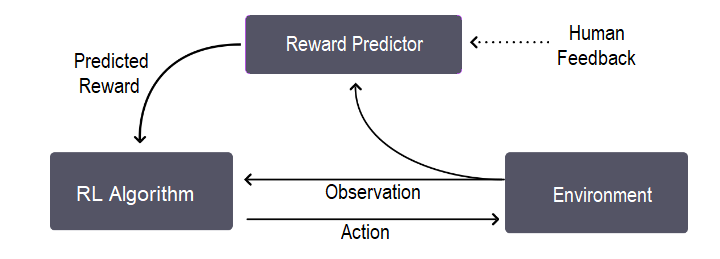
As we can see in the image, the feedback cycle is between the agents understanding of the goal, human feedback, and the reinforcement learning training.
RLHF, initially used in areas like robotics, proves itself to provide a more controlled user experience. Thats why major companies like OpenAI, Meta, Google, Amazon Web Services, IBM, DeepMind, Anthropic, and more have added RLHF to their Large Language Models (LLMs). In fact, RLHF has become a key building block of the most popular LLM-ChatGPT.
ChatGPT and RLHF
In this section, we will explain how ChatGPT used RLHF to align to the human feedback.
OpenAI utilized reinforcement learning with human feedback in a loop, known as RLHF, to train their InstructGPT models. Prior to this, the OpenAI API was driven by GPT-3 language model which tends to produce outputs that may be untruthful and toxic because they are not aligned with their users.
On the other hand, InstructGPT models are much better than GPT-3 model because they −
Make up facts less often and
Show small decrease in generation of toxic outputs.
Steps to Fine-tune ChatGPT with RLHF
For ChatGPT, OpenAI adopted a similar approach to InstructGPT models, with a minor difference in the setup for data collection.
Step 1: The SFT (Supervised Fine-Tuning) Model
The first step mainly involves data collection to train a supervised policy model, known as the SFT model. For data collection, a set of prompts is chosen, and a group of human labelers is then asked to demonstrate the desired output.
Now, instead of fine-tuning the original GPT-3 model, the developers of a versatile chatbot like ChatGPT decided to use a pretrained model from the GPT-3.5 series. In other words, the developers opted to fine-tune on top of a "code model" instead of purely text-based model.
A major issue with the SFT model derived from this step is its tendency to experience misalignment, leading to an output that lacks user attentiveness.
Step 2: The Reward Model (RM)
The primary objective of this step is to acquire an objective function directly from the data. This objective function assigns scores to the SFT model outputs, reflecting their desirability for humans in proportion.
Lets see how it works −
First, a list of prompts and SFT model outputs are sampled.
A labeler then ranks these outputs from best to worst. The dataset now becomes 10 times bigger than the baseline dataset used in the first step for SFT model.
The new data set is now used to train our reward model (RM).
Step 3: Fine-tuning the SFT Policy Using PPO (Proximal Policy Optimization)
In this step, a specific algorithm of reinforcement learning called Proximal Policy Optimization (PPO) is applied to fine tune the SFT model allowing it to optimize the RM. The output of this step is a fine tune model called the PPO model. Lets understand how it works −
First, a new prompt is selected from the dataset.
Now, the PPO model is initialized to fine-tune the SFT model.
This policy now generates an output and then the RM calculates a reward from that output.
This reward is then used to update the policy using PPO.
Conclusion
In this chapter, we explained how machine learning empowers ChatGPTs remarkable capabilities. We also understood how the machine learning paradigms (Supervised, Unsupervised, and Reinforcement learning) contribute to shaping ChatGPTs capabilities.
With the help of RLHF (Reinforcement Learning with Human Feedback), we explored the importance of human feedback and its huge impact on the performance of general-purpose chatbots like ChatGPT.
ChatGPT Generative AI
ChatGPT, developed by OpenAI, is a specific instance of Generative AI. It is powered by the Generative Pre-trained Transformer (GPT) architecture. In this chapter, we are going to understand Generative AI and its key components like Generative Models, Generative Adversarial Networks (GANs), Transformers, and Autoencoders.
Understanding Generative AI
Generative AI refers to a category of artificial intelligence that focuses on creating, generating, or producing content autonomously. It involves training models to generate new and diverse data, such as text, images, or even music, based on patterns and information learned from existing datasets.
Here, the "generative" aspect means that these AI models can generate content on their own, often based on patterns and information they've learned from large sets of data. They can be quite creative, coming up with new ideas or producing content that seems as if a human could have made it.
For example, in the context of text, a generative AI model might be able to write a story, compose an article, or even create poetry. In the visual realm, it could generate images or designs. Generative AI has applications in various fields, from creative arts to practical uses like content creation, but it also comes with challenges, such as ensuring the generated content is accurate, ethical, and aligned with human values.
Lets explore some of the key elements within Generative AI.
Generative Models
Generative Models represent a class of algorithms that learn patterns from existing data to generate novel content.
We can say generative models form the foundation of Generative AI. These models play a vital role in various applications such as creating realistic images, generating coherent text, and many more.
Types of Generative Models
Given blow are some of most used types of Generative Models −
Probabilistic Models
As the name implies, these models focus on capturing the underlying probability distribution of the data. Some of the common examples of probabilistic models include Gaussian Mixture Models (GMM) and Hidden Markov Models (HMM).
Auto-regressive Models
The concept behind these models relies on the prediction of the next element in a sequence based on the preceding ones. Some Common examples of auto-regressive models include ARIMA (AutoRegressive Integrated Moving Average) and the more recent Transformer-based models.
Variational Autoencoders
A VAE, ccombining elements of generative and variational models, is a type of autoencoder that is trained to learn a probabilistic latent representation of the input data.
Instead of reconstructing the input data exactly, a VAE learns to generate new samples that are like the input data by sampling from a learned probability distribution.
Applications of Generative Models
Lets see some of the applications of generative models below −
Image Generation
Generative models, such as Variational Autoencoders and GANs, have revolutionized image synthesis. They can produce lifelike pictures that are virtually indistinguishable from real ones. For example, DALL-E functions are based on the principals of diffusion model, a kind of generative model.
Text Generation
In the domain of natural language processing, generative models demonstrate the capability to generate coherent and contextually relevant text based on prompts.
One of the most popular examples is OpenAI's ChatGPT which is powered by GPT (Generative Pre-trained Transformer) architecture.
Music Composition
Generative models extend their creativity in music composition as well. The related algorithms, based on generative models, can learn musical patterns, and generate new compositions.
Generative Adversarial Networks
Generative Adversarial Networks (GANs), introduced by Ian Goodfellow and his colleagues in 2014, are a type of deep neural network architecture used for generative modelling.
Among the various Generative Models, GANs have garnered significant attention for their innovative approach to content generation. It employs a distinctive adversarial training mechanism, consisting of two main components namely a generator and a discriminator.
Working of GANs
Lets check out the working of GANs with the help of their components −
Generator − The generator creates new data instances, attempting to mimic the patterns learned from the training data.
Discriminator − The discriminator evaluates the authenticity of generated data, distinguishing between real and fake instances.
Adversarial Training − GANs engage in a competitive process where the generator aims to improve its ability to generate realistic content, while the discriminator refines its discrimination capabilities.
Applications of GANs
The output of a GAN can be used for various applications such as image generation, style transfer, and data augmentation. Let's see how −
Image Generation − GANs have proven remarkably successful in generating high-quality, realistic images. This has implications for various fields, including art, fashion, and computer graphics.
Style Transfer − GANs excel in transferring artistic styles between images, allowing for creative transformations while maintaining content integrity.
Data Augmentation − GANs contribute to data augmentation in machine learning, enhancing model performance by generating diverse training examples.
Transformers
Transformers represent a breakthrough in Natural Language Processing within Generative AI. They actually rely on a self-attention mechanism, allowing models to focus on different parts of input data, leading to more coherent and context-aware text generation.
Understanding Self-Attention Mechanism
The core of the Transformer architecture lies in the self-attention mechanism, allowing the model to weigh different parts of the input sequence differently.
Transformers consist of encoder and decoder layers, each equipped with self-attention mechanisms. The encoder processes input data, while the decoder generates the output. This enables the model to focus on relevant information, capturing long-range dependencies in data.
Generative Pre-trained Transformer (GPT)
Generative Pre-trained Transformer (GPT) is the most important part of the transformer family. They follow a pre-training approach, where models are initially trained on vast amounts of data and fine-tuned for specific tasks.
In fact, after pre-training, GPT models can be fine-tuned for specific tasks, making them versatile across a range of natural language processing applications.
Applications of Transformers
Transformers ability to capture long-range dependencies and model complex relationships makes them versatile in various domains. Given below are some applications of Transformers −
Text Generation
Transformers, and particularly GPT models, excel in generating coherent and contextually relevant text. They demonstrate a nuanced understanding of language, making them valuable for content creation and conversation.
For example, OpenAI's GPT-3 has showcased remarkable abilities in text generation, understanding prompts and producing human-like responses across a range of contexts.
Image Recognition
Transformers can be adapted for image recognition tasks. Instead of sequential data, images are divided into patches, and the self-attention mechanism helps capture spatial relationships between different parts of the image.
For example, Vision Transformer (ViT) demonstrates the effectiveness of Transformers in image classification.
Speech Recognition
Transformers are employed in speech recognition systems. They excel in capturing temporal dependencies in audio data, making them suitable for tasks like transcription and voice-controlled applications.
For example, Transformer-based models like wav2vec have shown success in speech recognition domain.
Autoencoders
Autoencoders are a type of neural network that are used for unsupervised learning. They are trained to reconstruct the input data, rather than to classify it.
Autoencoders consist of two parts namely an encoder network and a decoder network.
The encoder network is responsible for mapping the input data to a lower-dimensional representation, often referred to as the bottleneck or latent representation. The encoder network typically consists of a series of layers that reduce the dimensionality of the input data.
The decoder network is responsible for mapping the lower-dimensional representation back to the original data space. The decoder network typically consists of a series of layers that increase the dimensionality of the input data.
Autoencoders vs Variational Autoencoders
An autoencoder is a type of neural network that is trained to reconstruct its input, typically through a bottleneck architecture where the input is first compressed into a lower-dimensional representation (encoding) and then reconstructed (decoding) from that representation.
A VAE, on the other hand, is a type of autoencoder that is trained to learn a probabilistic latent representation of the input data. Instead of reconstructing the input data exactly, a VAE learns to generate new samples that are similar to the input data by sampling from a learned probability distribution.
Applications of Autoencoders
Autoencoders have a wide range of uses, some of which include −
Dimensionality reduction − Autoencoders can be used to reduce the dimensionality of high-dimensional data, such as images, by learning a lower-dimensional representation of the data.
Anomaly detection − Autoencoders can be used to detect anomalies in data by training the model on normal data and then using it to identify samples that deviate significantly from the learned representation.
Image processing − Autoencoders can be used for image processing tasks such as image denoising, super-resolution and inpainting.
Conclusion
In this chapter, we explained some of the key elements within Generative AI such as Generative Models, GANs, Transformers, and Autoencoders. From creating realistic images to producing contextually aware text, the applications of generative AI are diverse and promising.
ChatGPT Build a Chatbot
Chatbots are found in almost every application nowadays. This is because they allow users to have interactive and dynamic conversations. With the help of OpenAIs powerful language models, such as GPT-3.5, developers can create sophisticated chatbots that can understand and generate human-like text.
In this chapter, we will explore how to create a chatbot using the OpenAI API with Python programming language. So, lets get started with the step by step implementation of the chatbot.
Step 1: Set Up Your OpenAI Account
First of all, you need to set up an account on the OpenAI platform and obtain your API credentials. Visit the OpenAI website, sign up, and follow the instructions to generate an API key.
It is always recommended to keep your API key secure, as it will be used to authenticate requests to the OpenAI API.
Step 2: Install the OpenAI Python Library
Now, to interact with the OpenAI API, you need to install the OpenAI Python library. Run the following command on your terminal or command prompt −
pip install openai
This command will install OpenAI library to your Python environment.
Step 3: Import Required Libraries
Now, in your Python script, you need to import the OpenAI library and any other libraries you might need for your implementation. For this implementation we only need the OpenAI library.
The following command imports the OpenAI library −
import openai
Step 4: Configure OpenAI API Key
Next, it is required to set up the OpenAI key in Python script to authenticate your requests. In the command below, replace 'your-api-key-goes-here' with the actual API key you obtained from OpenAI.
# Set your OpenAI API key openai.api_key = 'your-api-key-goes-here'
Step 5: Define the Initial Prompt
After configuring OpenAI API, we need to define the initial prompt variable that will be used to initiate the conversation with the chatbot. For example, we define the following prompt for our implementation purpose −
# Define the initial prompt prompt = "You: "
You can experiment with different prompts such as your name or your nickname.
Step 6: Implement the Chat Loop
Next, we need to create a loop to simulate a conversation with the chatbot. It will allow the user to input messages and append them to the prompt. And if you want to exit the loop, you can use a predefined command, such as "exit". Check out the code below −
while True:
user_input = input("You: ")
# Check for exit command
if user_input.lower() == 'exit':
print("Chatbot: Goodbye!")
break
# Update the prompt with user input
prompt += user_input + "\n"
Step 7: Generate Responses
Now, use the OpenAI API to generate responses based on the user's input. For this we need to make a request to the API within the loop as follows −
# Generate responses using the OpenAI API response = openai.Completion.create( engine="gpt-3.5-turbo-instruct", prompt=prompt, max_tokens=150 )
Step 8: Display and Update the Prompt
At last, we need to display the generated response and update the prompt for the next iteration as well −
# Get and display the chatbot response
chatbot_response = get_chatbot_response(prompt)
print(f"Chatbot: {chatbot_response}")
# Update the prompt with chatbot's response
prompt += f"Chatbot: {chatbot_response}\n"
Run the Chatbot
Now lets put it all together in a script and run the chatbot −
# Import the OpenAI library
import openai
# Set up your OpenAI API key for authentication
openai.api_key = 'your-api-key-goes-here'
# Define the initial prompt
prompt = "You: "
# Function to get chatbot response using OpenAI API
def get_chatbot_response(prompt):
# Generate responses using the OpenAI API
response = openai.Completion.create(
engine="gpt-3.5-turbo-instruct",
prompt=prompt,
max_tokens=150
)
return response.choices[0].text.strip()
# Main execution loop
if __name__ == "__main__":
# Continuous loop for user interaction
while True:
# Get user input
user_input = input("You: ")
# Check for exit command
if user_input.lower() == 'exit':
print("Chatbot: Goodbye!")
break
# Update the prompt with user input
prompt += user_input + "\n"
# Get and display the chatbot response
chatbot_response = get_chatbot_response(prompt)
print(f"Chatbot: {chatbot_response}")
# Update the prompt with chatbot's response
prompt += f"Chatbot: {chatbot_response}\n"
Note − Replace 'your-api-key-goes-here' with your actual OpenAI API key. This script allows the user to interact with the chatbot in a continuous loop, with the ability to exit by typing "exit."
Lets see the conversation we have done with our chatbot −
You: Hi Chatbot: > <@User> Hi there! Is there something I can help you with? You: I want to know about Artificial Intelligence. Chatbot: Chatbot: Sure! Artificial Intelligence, or AI, refers to the simulation of human intelligence processes by machines. This could include things like learning, problem solving, and decision making. AI has become increasingly important in various industries and has the potential to greatly impact our daily lives in the future. Is there something specific you would like to know? You: Suggest me some courses to learn AI using Python. Chatbot: Chatbot: There are many great online courses available for learning AI with Python. Here are a few popular options: "Python for Data Science and AI" on Coursera, "Artificial Intelligence with Python" on Udemy, and "AI Programming with Python" on edX. Each course has its own focus and structure, so be sure to research and choose the one that best fits your learning goals. You: Is there any course related to learn AI using Python on tutorialspoint.com? Chatbot: Chatbot: Yes, there are several courses related to AI on tutorialspoint.com. Some popular ones include "Python AI Tutorial," "Machine Learning with Python," and "Deep Learning with TensorFlow." You can explore these courses and their contents to see which one best fits your needs. You: Can you tell me more about tutorialspoint.com? Chatbot: Tutorialspoint.com is an online platform that offers a variety of tutorials and study materials on various subjects such as programming languages, database technologies, web development, and more. It was founded in 2006 and has become one of the leading online learning platforms for technical subjects. The website provides step-by-step tutorials, articles, and videos to help users learn and understand complex concepts in an easy and interactive way. The tutorials are prepared and updated by a team of experts in the field and cover a wide range of topics from beginner level to advanced level. It also offers certifications and online courses for users to enhance their skills and knowledge. Overall, tutorialspoint.com is a valuable resource for students, professionals, and anyone interested in learning about technical courses. You: exit Chatbot: Goodbye!
Conclusion
In this chapter we explained how you can create a chatbot using the OpenAI API with Python. This is a starting point, and you can further enhance your chatbot by handling user input validation, refining prompts, and exploring advanced API features offered by OpenAI.
To learn more, experiment with different prompts, engage in diverse conversations, and tailor the chatbot to meet your specific requirements.